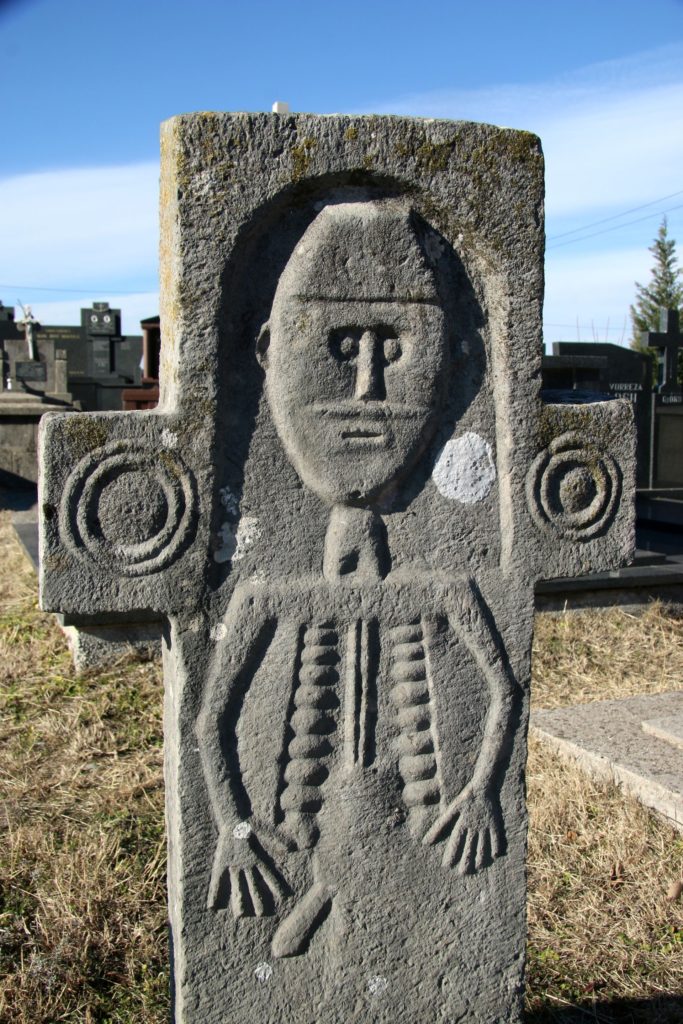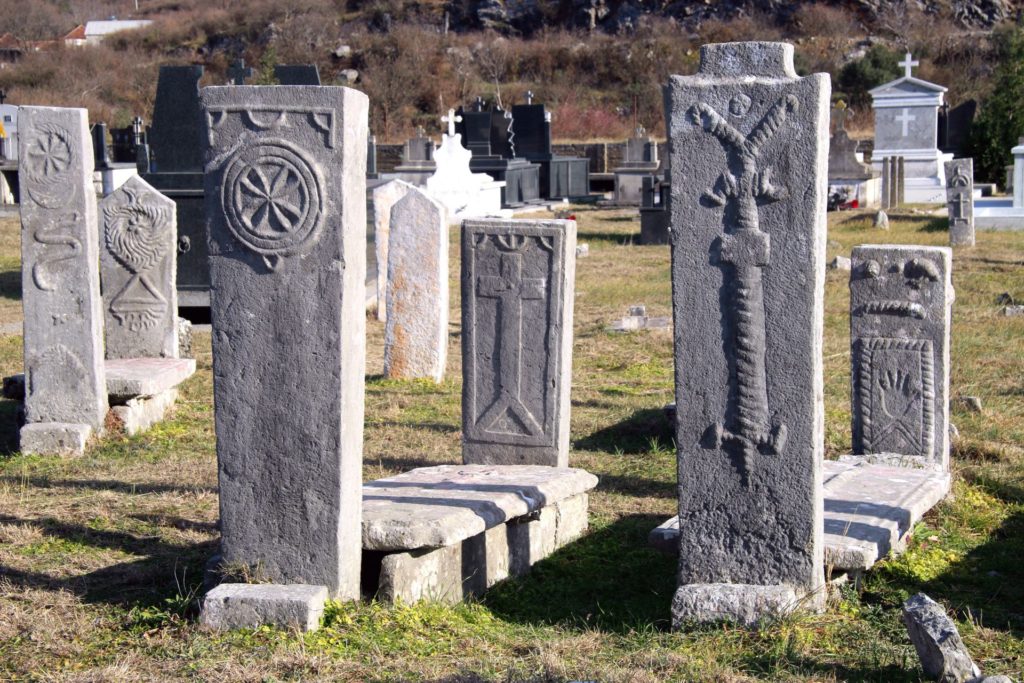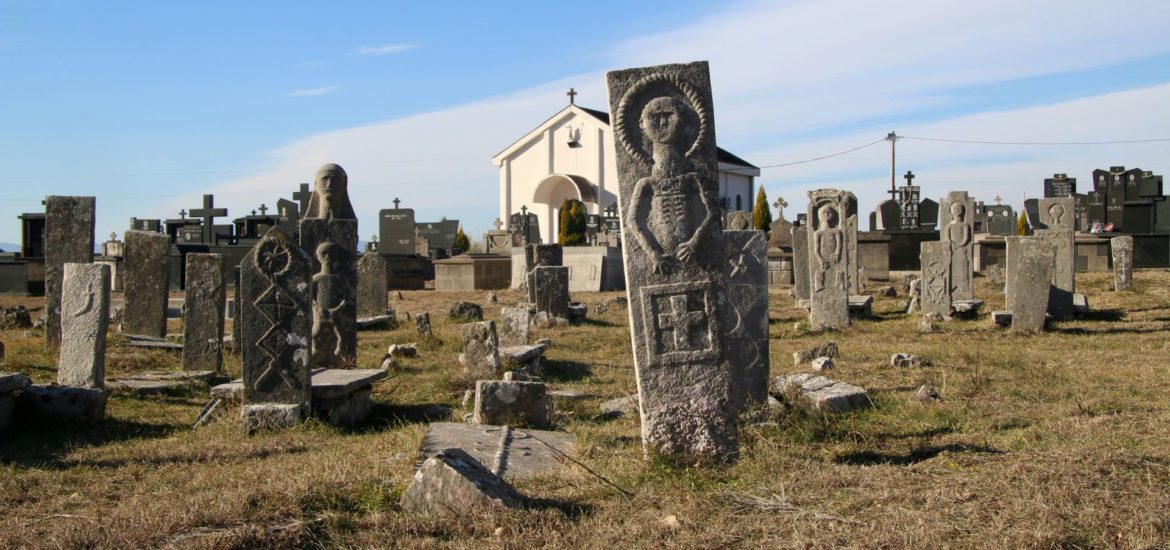Although I have spent most of my life in Montenegro and I have crisscrossed it numerous times, it is obvious that there are still many things to discover.
 A friend from Shkodra gave us a precious tip: he told us about a mysterious cemetery with amazing old tombstones in the village of Vuksanlekaj, near Tuzi, in the region of Malesia that is mostly populated by a catholic Albanian tribe, the Malissores.
A friend from Shkodra gave us a precious tip: he told us about a mysterious cemetery with amazing old tombstones in the village of Vuksanlekaj, near Tuzi, in the region of Malesia that is mostly populated by a catholic Albanian tribe, the Malissores.
And thus we hit the road in the direction of the Montenegrin/Albanian border. We passed the town of Tuzi and soon (around 14 km from Podgorica) we noticed the modern funeral centre of Vuksanlekaj on the left side of the road. Behind it we saw a small catholic church in the distance and so we turned left, following the narrow asphalt road to the cemetery.
It turned out to be quite a big cemetery with huge family graves made of black marble and decorated with rosaries and religious statues. But … in the middle of the cemetery ground, we discovered a group of old graves as we had never seen before. There were around 30 of them, with carved tombstones, between 100 and 150 cm high. The graves were all turned towards west.
Carving was done on the front and back of the headstones, and also on the plate cover. The carved symbols were amazing: crosses associated with other symbols; moon, sun and stars; rifles and swords; shepherd sticks; snakes; fauna and flora elements….
Many of them showed human figures. Most impressive were an old man in national dress, a woman adorned with armor and a mother with child. The graves did not contain any names or other inscriptions.
 Unfortunately, I could not find any information about the tombstones on the internet. Some Albanian sites mentioned the cemetery and made an appeal to historians and other experts to do research about the tombstones, as this old cemetery can tell a lot about life and development of the Malesia region. The tombs are probably between 200 and 400 years old, but some of them might even be older.
Unfortunately, I could not find any information about the tombstones on the internet. Some Albanian sites mentioned the cemetery and made an appeal to historians and other experts to do research about the tombstones, as this old cemetery can tell a lot about life and development of the Malesia region. The tombs are probably between 200 and 400 years old, but some of them might even be older.
It was good to find the note that three Albanian experts recently wrote a book about this topic, called “A monumental testimony in Vuksanlekaj”. The book gives information about funeral rites of the indigenous people, coupled with ethnographic data. The text is also translated into English and Montenegrin, but unfortunately, we didn’t know where to find it …
Montenegro hides many secrets. Numerous historical and archeological sites in the country need additional research. It is always a special pleasure for me to discover such places. Are there any readers of my blog who can give me some tips?

The book is called:DESHMI MONUMENTALE NË VUKSANLEKAJ (A MONUMENTAL TESTIMONY IN VUKSANLEKAJ – SPOMENICI U VUKSANLEKAJIMA).
Search: http://www.bksh.al or http://www.bibliotekashkoder.com
Search: You Tube (VARREZAT NE VUKSANLEKAJ) Star Plus Tv 2016
Thank you for the information. I will buy the book as soon as I come to Albania. All the best, Marianne
My grandfather is buried there. He has one of the large black granite memorials. What’s funny is that after seeing your blog I now remember those older tombstones but don’t remember the story behind them. I will ask my parents when I see them and see if I uncover anything 🙂
I grow up right down the street from there till I was 11 my father told me a lot of story’s and I walked around that area a lot there is so much more history even about the Turkish soldiers buried there.
My mom is from Vuksanaj. She don’t remember seeing those tombstone. And she lived And grew up right next door to the cemetery. Mare Kolja Dedvukaj . Did they find these monuments recently .
They have been there for 500 years
There aren’t any Turks buried there.
Hello, Marianne Van Twillert
Locals in the construction of houses and the processing of the land are found on graves, fragments of stone urns, remnants of walls made in mortar, ceramic fragments and the like. Here was also found a Roman milestone, as well as two epigraphic monuments, embedded in the bell tower of the Catholic Church in Tuzi. All these finds belong to the antique and late antique period.
Judging, according to the order of several stone and earthen tumuli on the slopes and at the foot of Hum, belonging to the Hallstatt, it can be concluded that this place was inhabited even in prehistory.
From the later medieval period, the location of Đafkiši is located on the road from Vuksanlekić to the neighboring Dubrava with the remains of the church and cemetery. The church is one-nave, built in plaster and oriented east – west. The most respected among the locals is the church on Đaf Kiši, which they say was built by the kavuri who lived here before today’s Hots.
Here, prominent chief Vuksan Lek, after whom the village got its name, built a large house (kulu=tower) with fortifications for himself and his four sons (Nika, Ujka, Smailj and Martin) while the fifth son (Ljulja) remained to live in the old homeland, in Spinja above Dubrava, that is on the right side of the road towards the Skoraće. This data dates back to the first half of the 18th century (with a time interval of approximately 267-317 years ago), at the time of the expansion and expansion of Hota towards the north and south, the northeast part of the Zeta Plain, towards the Skadar Lake, was intensified by their settling. Expanding and strengthening newcomers Hots (Kečins descendants) it came to crowding out of the elderly population, whose considerable part moved to some parts of the Zeta Plain.
By the Vuksan Lekas old house (kula=tower) in the middle of last century, Hasan’s Nike Camaja´s large house was built, who as a prominent representative of Hota, with his tribesmen, participated in the uprising of Zećana in 1832. against the Turks. After the unsuccessful uprising, Hasan Nika (in the people known as As Nika) found a refuge with Njegoš (Petar II Petrović Njegoš) in Cetinje, with whom he remained for some time and became a good friend. After secured return, he returned to his village, where, with Njegoš’s help, and especially with the help of Zećana, to the transit house, he quickly built a new large house. His descendants continued to maintain friendly relations with the Petrović dynasty.
This house, the so-called Kula Chamaja, is a unique monument of architecture in this region. As a typical house – a fortification, it was built of roughly knitted stone of bound lime mortar. The house is surrounded by high walls with loopholes, a gate and two defensive floor towers. The house is also upstairs construction with wide walls and massive volts in the lower and a porch on the upper floor.
In all likelihood and probability, from that time onwards, the village cemetery of this village dates the monuments with the relief of the deceased, various solar and htonian motifs related to the spiritual culture of the people living here. As such, they represent unique monuments.
Best regards and all the best to Marianne Van Twillert
Sorry for the delayed response, I was absent from Podgorica. Thank you so much for the interesting information. I really love to learn more about historical facts. Should you have more tips, please let me know. Or maybe you could mention a book where I can find more details about history of the area? Thalnks again and all the best, Marianne
Hi
Very odd site – love it!
I ll be in montenegro next week. Is it in the village actually called vuksanlekici on google map? Thanks for your help!
Yes, that ‘s right. Have a nice time!
Here is my comment I left on my Facebook Page for my followers in response to one of the gravestones (7th picture in the slide after gravestone with woman and child) I was looking at:
Due to my work involving symbolism, mythology, astrology and ancient times. I noticed something very cool! Im very excited to share this 😁 These symbols are used in astrology, paganism, ancient times and have been incorporated in modern times.
In this picture here on the gravestone they have the symbol of the intertwined/coiled snakes (Caduceus) and a small cross in the middle. The coiled snakes represents DNA and healing. As a matter of fact its the symbol that represents the nakshatra Ashlesha. The coiled snakes symbol has been used throughout ancient times and we see it in astrology which can indicate the the person is a healer such as a Holistic healer, Medicine man/woman, Ayurvedic healer, Spiritual healer or Astrologer. Someone with Divine Knowledge.
This symbol represents people are very knowledgable in herbs and spices and the stars. Modern times have adopted this symbol in the medical community. I have great reason to believe this person was known as a some kind of healer or had deep knowledge of the stars.
Now the cross in the middle could represent that they have adapted Christianity and perhaps merged it with paganism. OR it can be symbolic of how we understand the Red Cross today. Someone who comes to heal in times of emergencies.
I also have suspicion to believe that perhaps this person could have been a an OBGYN or some sort of midwife. I say this because we also have another symbol underneath it. This is the symbol of the downward facing moon. In Astrology it represents Moon, Rahu or the north Node. BUT ultimately it represents the Moon. Because the Sun’s symbol is the Circle and in ancient times they would use the crescent to represent Moon in order to differentiate the two. Moon is also symbolic of the Mother, High Priestess, fertility, water, weather, etc This can show meaning that the person buried was a Woman, a High Priestess, Healer, knew about agriculture, herbs, spices, healing, fertility, motherhood, spirituality, etc.
I thought this gravestone was super insightful and gave more meaning to their lives back then.
Marianne, There is a gentleman named Anton Pllumaj that may be able to help. He’s local in Tuzi. Very much into the history of Albanians. Perhaps reach out to him via facebook. Good Luck!!!
Thank you so much, I will certainly contact him. Best regards!
Unfortunately, mr Pllumaj is not willing to share his knowledge, information and studies with me.
The time has come for us to write our history as it was and not as foreigners have written to us in the past.
I would really like to hear the real history about these tombs. Why don’t you publish an article about it?
[…] After we passed Tuzi (around 14 km from Podgorica) we noticed a modern funeral centre on the left side of the road and behind it a small Catholic church in the distance. We turned left and followed the narrow asphalt road to the church, where we visited the interesting cemetery of Vuksanlekaj, which I already described in my blog post „The mysterious cemetery of Vuksanlekaj“. […]